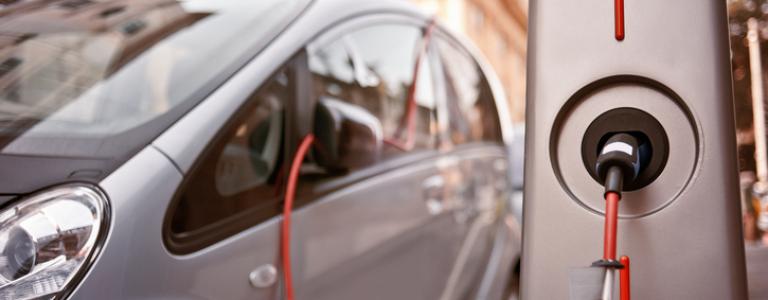Electric Vehicles vs. Fuel-Efficient Used Cars: Which really drives sustainability?
Debates surrounding the merits of electric vehicles versus fuel-efficient used cars have typically focused on carbon emissions and energy use only—but what of the conflict implications?
It finally happened.
Your 1995 Honda Civic hatchback broke down after 23 reliable years of week-long road trips, 8:00 AM traffic jams and carpools to the cottage.
It’s time to move on to a new car—but which model will contribute to a more sustainable future?
The obvious path to a low-carbon future seems to be via electric vehicles (EVs). EVs fall directly in line with the United Nation’s global Sustainable Development Goals (SDGs), especially SDG 7: Clean energy. But to truly understand the global consequences of each car, all aspects of sustainability need to be addressed, including SDG 16: Peace and justice.
First, let’s look at the energy consequences of EVs and fuel-efficient used cars.
In the past decade, EVs have been accelerating in popularity and demand, and are projected to make up 54 per cent of new car sales by 2040. The United Kingdom and France have both announced they will ban the sale of diesel- and gasoline-fuelled cars by 2040, pivoting to EVs to curb the flow of carbon emissions. The private sector is also along for the ride, with companies like Ikea, Metro and Unilever joining up for the EV100 initiative, to encourage global business commitments to electric transport.
But what about fuel-efficient used cars?
In 2008, Wired wrote that a fuel-efficient used car may ultimately be better for the environment than a hybrid, due to the sheer amount of energy required to produce EVs and hybrid cars. A Toyota Prius, for example, wrote Wired, consumes the equivalent of 1,000 gallons of gasoline in its construction. For used cars, this “carbon debt” has already been paid.
Cobalt, aluminum, manganese, nickel and lithium have all been identified as critical raw material inputs for the EV market. Unfortunately, the places they are found are often mired in conflict.
And just last year, a European Union study found that it takes more energy to generate and transport electricity to the EVs then it does to extract and transport petrol to fuel-powered cars. (However, once in the car, an EV uses considerably less energy to move itself and its passengers—thereby being more energy-efficient overall).
These arguments for and against electric vehicles and gasoline-powered used cars are fuelled by their respective implications for the global carbon footprint. But discussions of sustainability, as we are all becoming increasingly aware, are not limited to the environment.
Powering EVs requires rechargeable batteries, and rechargeable batteries require raw materials. Cobalt, aluminum, manganese, nickel and lithium have all been identified as critical raw material inputs for the EV market. Unfortunately, the places they are found are often mired in conflict.
Cobalt, for example, is linked to child labour and ongoing armed conflicts in the Democratic Republic of Congo (DRC). Demand for cobalt has surged in the last decade, due to its use in smartphones and electronics. About 50 per cent of global cobalt reserves are located in the DRC, and many cobalt mines are run by violent armed groups.
The increased extraction of nickel, another key mineral for EVs, also has links to violence; in Guatemala, military and private security personnel linked to mining companies have been accused of murder, violence and rape against local communities.
Beyond the DRC and Guatemala, protest and conflict associated with nickel, lithium, manganese and more have been recorded in Bolivia, India and the Philippines, to name only a few.
But that doesn’t mean we have reached the end of the road for the prospect of a conflict-free EV.
Global regulations and guidance have been put in place by governments, the private sector and non-governmental organizations to address the contested extraction of strategic minerals, and many apply to those minerals and metals required for EVs. This week alone, more than 700 stakeholders are coming together for the OECD’s Forum on Responsible Mineral Supply Chains to discuss initiatives to enable conflict-free mineral production and sourcing. Included in the agenda for discussion: cobalt.
While the debate over EVs and fuel-efficient used cars is far from solved, one thing is certain: to decide how sustainable a car is, we need to look at its links to conflict and not just its carbon footprint.
What do you think? Tweet your opinions on EVs vs. fuel-efficient used cars to @IISD_Resilience with the hashtag #SustainableCars and we’ll post your thoughts below!
You might also be interested in
What Will Happen at COP 29?
Talks at the 2024 UN Climate Change Conference (COP 29) will range from defining a way forward on finance through a new collective quantified goal (NCQG) to mitigation, and loss and damage. Ahead of negotiations in Baku, IISD’s Earth Negotiations Bulletin Team Lead Jennifer Bansard examines the agenda and breaks down what to watch as eyes turn to Azerbaijan.
Addressing Liquidity Challenges: A conceptual framework
A conceptual framework for addressing liquidity challenges in sovereign debt.
Senegal's Big LNG Gamble
This report explores Senegal's nascent liquefied nitrogen gas (LNG) industry by assessing the impacts associated with a new fossil fuel-based industry on the country's environment, economy, and society. It does this by responding to three questions: What have been the impacts of the development of LNG on Senegal to date? Is it viable for Senegal to invest further into an industry that is projected to decline? What risks can Senegal expect should it forge ahead with its LNG development plans?
Border Carbon Adjustment Mechanisms and Impacts on Vietnam
This report consolidates, analyzes, and presents views and perspectives of stakeholders from Vietnam on border carbon adjustment (BCA) schemes to contribute to the global debate on BCA good practices.
